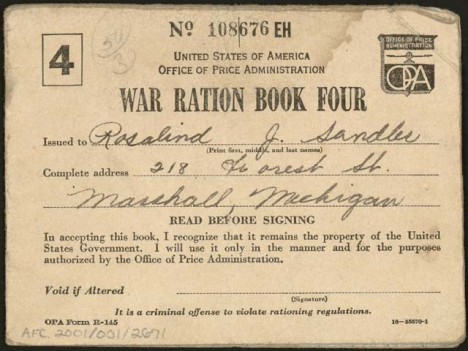The Ration Book Diet
United States Library of Congress Rosie the Riveter kept slim by following World War II’s most popular weight loss plan. And you can too. We’ve been stuck in a pesky recession since December 2007. Food prices in many categories continue to rise. At the same time, more people are gaining more weight, with an estimated 300 million people worldwide falling under the category of obese, and more than a billion people classified as overweight. More than 30 percent of people in the United States and 24 percent of British people are estimated to be obese. The world needs a diet plan that can both cut costs and help people lose weight. The good news is that we can look back to past economic hardships to find just such a


United States Library of Congress
Rosie the Riveter kept slim by following World War II’s most popular weight loss plan. And you can too.
We’ve been stuck in a pesky recession since December 2007. Food prices in many categories continue to rise.
At the same time, more people are gaining more weight, with an estimated 300 million people worldwide falling under the category of obese, and more than a billion people classified as overweight. More than 30 percent of people in the United States and 24 percent of British people are estimated to be obese.
The world needs a diet plan that can both cut costs and help people lose weight. The good news is that we can look back to past economic hardships to find just such a plan that can still work for people today: The Ration Book Diet.
How rationing worked
During World War II, all sorts of things were rationed, from rubber to meat and nylon to fuel. Regular people were asked to make sacrifices so there would be more food and resources available for the war effort.
People got ration books that included tokens and coupons that would allow them to buy certain amounts of necessary items, and no one was supposed to be able to buy more, even if they could afford it.
All sorts of items were rationed at one time or another, from bicycles and typewriters to cheese, fuel oil, coffee, sugar, processed food and canned milk. There were several different ration books used at different times in the war and the program was a great success, both in terms of keeping the military supplied with needed items and involving people at home in the war effort.
These days it’s not necessary for those of us back home to go without in order to support conflicts around the world, but using the mindset of rationing can still help us lose weight, save money and be more mindful of what we’re consuming.
The Ration Book Diet
The Ration Book Diet is actually a really simple diet plan. By limiting the amount of certain types of food you bring into the house each week, you’ll automatically be cutting calories. And if you add some other 1940s style dietary ideas to your daily life, you’ll start eating healthier, less processed foods, saving a lot of money on food and maybe even doing your part to save the planet.
Here are some of the food basics that were rationed during the war and how much of them you can eat each week when following the Ration Book Diet:
-
Meat: one and a half pounds
-
Sugar: eight ounces
-
Butter: four ounces
-
Cheese: four ounces
-
Cooking fat/oil: two ounces
-
Fruit and vegetables: two pounds
You’ll notice that all of these restricted items are actual foodstuffs that don’t come out of boxes or cans. That’s because there weren’t all the bizarre processed foods back then that there are today. If you want to truly follow the Ration Book Diet, you’ll learn to eat like a 1940’s person: choosing unprocessed, fresh foods whenever possible and in small quantities.
More World War II era diet tips
In addition to rationing meat, cheese and other products, there are other things you can do to lose weight on the Ration Book Diet. For instance, consider starting a garden. The Victory Gardens gave people a cheap supply of food that didn’t count toward their ration, and you can grow all the produce you want without counting it toward your total.
During the war there was even more specific rationing in the form of Wheatless Mondays and Meatless Tuesdays, days in which people were asked to eliminate those particular food products to increase supply. A day without wheat (or meat) can be a challenge for those who have never tried it before, but they make you ever more mindful of what you’re eating. It’s also a lot of fun to come up with new recipes for those -less days.
Consider cutting back on car trips as well. Gasoline was severely restricted during the war, such that cars that weren’t vital to the war effort were only allowed four gallons of gas a week. While you might not be able to cut down that far, see if you can add more walking and biking to your daily life (exercise helps with weight loss, as well as saving money and carbon emissions).
Finally, do what you can to avoid food waste. Even if you don’t stick strictly to rationed amounts, make one weekly trip to the store and imagine that you can’t get any more food that week. Find new uses for fruit that’s starting to turn or make a big pot of soup at the end of the week with all your extra vegetables. This will not only help you save money, it will cut down on the completely unnecessary food waste that’s clogging up landfills around the world.
Going back to our roots
Not only is the Ration Book Diet a simple way to lose weight, it can help us recapture something that many families in America and around the world have forgotten: the simple pleasure of actually cooking. There were few fast food restaurants in the 1940s; for the most part people actually had to cook for themselves, something many of us have forgotten.
British celebrity chef Jamie Oliver says it’s essential for people to learn to cook again and embrace healthy choices. He’s even started his own Ministry of Food in the hope that his healthy recipes can inspire a nation.
The Ration Book Diet provides the best of all possible worlds: one in which people are cooking healthy, unprocessed foods for themselves and their families, saving money and helping the planet all at once.
By Sarah E. White, Editor Emeritus.
The Ration Book Diet is a post from:
SOURCE: – Read entire story here.







